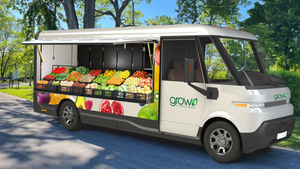Drone Delivery Offers a Cost Effective Alternative For Retailers and Consumers
Flytrex CEO discusses how on-demand drone delivery is changing how customers get their groceries.
July 12, 2022

With spiking inflation and gas prices, many consumers are left paying surging delivery service fees. But some companies are trying a different approach: drone delivery. Recently, Yariv Bash, CEO and co-founder of on-demand drone delivery company Flytrex spoke to WGB about this innovative, cost-efficient and eco-friendly delivery system that he says may be the standard in the future.
Jeniece Drake: Tell us about Flytrex.
Yariv Bash: Flytrex is basically a food or meal ordering app with a drone. We’re not a drone company, but we’re using drones instead of humans, and that allows us to get you your food a lot hotter and faster.
(Bash says Flytrex is starting mainly with food, but they deliver grocery store items as well.)
What companies does Flytrex work with?
We do have a pilot with Walmart. A lot of times people need something, just a single item—diapers for the baby...milk, or a bottle of wine for dinner. That’s something that instead of getting into a car and driving to the shopping center, you can order that via drone. In the stations that have a Walmart nearby, you can actually order those items.
(According to the Flytrex app, customers can order items from Target as well. Not to mention, pizza, wings, burgers, sandwiches, ice cream, and coffee from a myriad of restaurants.)
What are the benefits of drone delivery?
It’s 100% electric, no gas charges. Hopefully (drones are) the standard in the future.
In what other ways specifically does/can Flytrex assist companies?
The other focus is on-demand delivery, more specifically for suburbs—the 82 million backyards in the U.S.—two-thirds of the population roughly.
How does drone delivery work? What are some of the highlights? What are some challenges?
Go on the app. Once the order is ready, one of the runners picks it up from the store, and goes a few hundreds of feet to the station (Flytrex has stations in North Carolina and Texas) that’s located in that shopping center. (The runner) loads it into the drone, presses a button, and that’s it. From that moment on, the drone autonomously flies to your backyard. You get a notification; you don’t have to do a thing. The drone lowers to roughly 80 feet, automatically releases the package, notifies you, and flies back.
(One of the highlights of drone delivery is) usually the first few times people are outside…you know, taking selfies, waiting for the drone. But after a few more times, people are just like “oh, the food is outside.” That’s what life is all about.
Flying between skyscrapers (is a city delivery challenge, and) is not as safe as flying above the trees in the suburbs. If you have a backyard, you can just pick up from the backyard or front lawn, but not if you live in an apartment building.
What would you say delivery as a whole looks like in the near future?
I think in a decade from now, it’s going to look really weird that we actually had a human being driving from one place to the next.
What else would you like to add?
I’d like to stress that nobody has to worry. Skies are not going to be filled with drones that will be covering the skies. When we’re cruising, you can really barely hear or see us.
About the Author
You May Also Like




